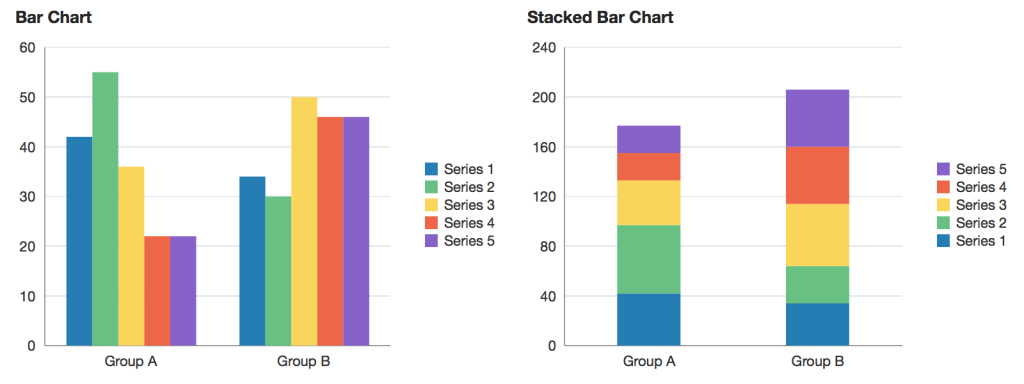In the realm of data analysis, where information is abundant and complex, the ability to convey insights in a comprehensible manner is crucial. Enter the barchart, a visual representation that has stood the test of time, aiding in the clear communication of data trends and comparisons. In this article, we will delve into the world of bar-charts, exploring their history, types, applications, and the impact of technology on their evolution.
History of Barcharts
The humble barchart has a rich history dating back to the 18th century. Originally used for economic data, bar-charts have evolved from simple graphical representations to sophisticated tools for conveying intricate information. The journey of the barchart mirrors the progression of data visualization as a whole.
Types of Barcharts
Bar-charts come in various forms, each suited for different purposes. Vertical bar charts are the most common, presenting data in an upright position. On the other hand, horizontal bar charts are effective when dealing with categorical data. Stacked bar charts allow for the visualization of the total and its components, offering a more nuanced perspective.
When to Use Barcharts
Knowing when to deploy a barchart is essential. Bar-charts excel in comparing values and illustrating trends over time. They provide a straightforward visual cue that resonates with audiences across diverse domains.
Creating Effective Barcharts
Crafting an effective barchart involves careful consideration of the type best suited for the data at hand. Proper labeling, scaling, and the choice of colors contribute to the clarity and impact of the visual representation.
Common Mistakes to Avoid
Despite their simplicity, bar-charts can be misinterpreted if not executed correctly. Avoiding misleading scaling and ensuring adequate labeling are critical to preventing misunderstandings.
Advantages of Barcharts
The simplicity of bar-charts is a strength. They offer an easy-to-understand visual representation, making data interpretation accessible to a broad audience. In scenarios where quick comprehension is key, bar-charts shine.
Limitations of Barcharts
While bar-charts are powerful tools, they have their limitations. They may not be suitable for complex data sets that require a more intricate representation. Care should be taken to avoid oversimplification.
Barcharts in Data Visualization Tools
The integration of bar-charts in popular data visualization tools has further enhanced their utility. With customizable options, users can tailor bar-charts to their specific needs, ensuring a seamless integration into their analytical processes.
Barcharts vs. Other Data Visualization Methods
Comparing bar-charts with other visualization methods, such as line charts and pie charts, reveals the unique strengths of each. Bar-charts excel in certain scenarios where other methods may fall short.
Barcharts in Business
In the business world, bar-charts find widespread use in sales reports and marketing analytics. Their simplicity allows stakeholders to quickly grasp key insights, aiding in informed decision-making.
Barcharts in Education
In the realm of education, bar-charts play a crucial role in teaching students how to interpret data visually. The engagement factor of bar-charts makes them an effective tool for conveying complex concepts in a more digestible format.
Impact of Technology on Barcharts
As technology continues to advance, so does the functionality of bar-charts. Digital enhancements and interactive features have elevated bar-charts to new heights, offering users a dynamic and engaging experience.
Future Trends in Barcharts
Looking ahead, the incorporation of artificial intelligence is poised to revolutionize bar-charts. AI-driven enhancements promise to make bar-charts even more intuitive and adaptive to user needs, opening up new possibilities in data visualization.
Conclusion
In conclusion, the barchart remains an indispensable tool in the realm of data analysis. Its simplicity, versatility, and effectiveness make it a staple for conveying information in a visually compelling manner. As we navigate the ever-evolving landscape of data visualization, the barchart stands tall, ensuring that insights are not just analyzed but also understood.
FAQs:
- Are barcharts suitable for all types of data?
- Bar-charts are effective for many types of data but may not be ideal for extremely complex datasets that require more detailed visualization methods.
- Can barcharts be customized in data visualization tools?
- Yes, modern data visualization tools offer a range of customization options, allowing users to tailor bar-charts to their specific needs.
- What is the main advantage of using barcharts in business reports?
- The main advantage is the quick and easy interpretation of key insights, aiding stakeholders in making informed decisions.
- How have advancements in technology impacted barcharts?
- Technology has brought digital enhancements and interactivity, elevating bar-charts to a more dynamic and engaging level.
- What is the future of barcharts in data visualization?
- The future of barcharts involves the incorporation of artificial intelligence, promising more intuitive and adaptive visualizations for users.

